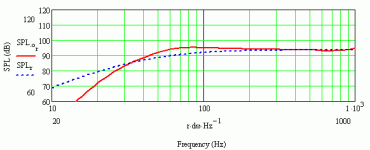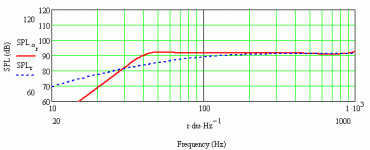I know roughly what to expect, but that's never quite the same as the reality is it?
Should sound best at around a 12' distance with the speakers around 8-10' apart ,off axis(aimed at the listener at zero) around 15 degrees toed in with the 207. Will give actual position on drums and such.
ron
Should sound best at around a 12' distance with the speakers around 8-10' apart ,off axis(aimed at the listener at zero) around 15 degrees toed in with the 207. Will give actual position on drums and such.
ron
Scottmoose said:🙂
Positions for drums. How many speakers can do that I wonder?
I thought it was the yardstick....I've never had a pair that couldn't lay out the kit precisely.......If they can't then they go the way of your last double horn....😀
ronc said:Will give actual position on drums and such.
Well, where the mix engineer and producer think the drums should be, at any rate. 😉
signature line (sorry for OT)
Hey Al,
I've seen that signature line before - you're taking it from the book I guess? Mine is from the original radio scripts... 😎
Ian (sorry for OT)
Hey Al,
I've seen that signature line before - you're taking it from the book I guess? Mine is from the original radio scripts... 😎
Ian (sorry for OT)
pinkmouse said:
Well, where the mix engineer and producer think the drums should be, at any rate. 😉
Hi Al
Well when I am the mix or master engineer I am allowed to say that....If they are in the mix where they were when I recorded them then its good enough for me....
Regards
Ed
Re: signature line (sorry for OT)
Yup, I'll have to find another one now! 🙂
Ian J said:I've seen that signature line before - you're taking it from the book I guess?
Yup, I'll have to find another one now! 🙂
I was refering to speakers with an over-under mouth layout. Unless they are differentially tuned, or the mouth is curved so that they act as a single vent, the lower can potentially come in at a lower frequency than the upper due to the floor reflection boundary condition. So you don't get quite the precision LF image that some other boxes can provide unless something like the curve is added. That said, there are plenty of other advantages to the over-under layout to set that slight negative off against. Everything's a compromise.
I like to think of it as one fairly huge rectangular vertical cone. Besides combining the wavefronts the curve shapes the waveform to a more spherical shape by allowing a faster expansion at the center and a slightly slower expansion at the top and bottom. Ity simply corrects for the total aspect ratio of the mouth, which at lower frequencies is the W x H of the opening.
ron
ron
Hi guys,
Just a quick question about this driver for the "Chang".
I saw it via Zaph's site.
http://www.hemptonespeakers.com/Hemptone FR 8.pdf
Ian
Just a quick question about this driver for the "Chang".
I saw it via Zaph's site.
http://www.hemptonespeakers.com/Hemptone FR 8.pdf
Ian
Re: Is Curvy Chang suitable with F200A
Sorry for the late reply, I'm struggling to keep up with things at present as I'm deep within my thesis so not much time for audio.
The F200a? Now you're talking! Fostex themselves suggest a 45 litre box for it, ironically enough (same as for the 206), so we're really in business here. It looks like it goes into the box rather well, with a max-flat 1/2 space response to ~40Hz.
They'll sound completely different to Bob's (excellent) FTA-2000. The latter is a TL, & should have a nicely damped sound. This is a reflex cabinet with huge horn-loaded vents, so it will sound (much) bigger, though with similar delicacy -huge vents have their advantages compared to the small ports used in most reflex enclosures. Both are great, but are really aimed at different people / different uses, so whichever you favour really.
whallen said:I know the Fostex F200A is compatible with the "Bruce" of the spawn family of enclosures, or at least I gather that it is from looking at the Frugel-Horn website. I like the Bruce, but I love the looks of the Curvy Chang.
One last thing, anybody have any idea on what
differences I might expect between the FTA-2000 and
the Spawn familt of speakers.
Sorry for the late reply, I'm struggling to keep up with things at present as I'm deep within my thesis so not much time for audio.
The F200a? Now you're talking! Fostex themselves suggest a 45 litre box for it, ironically enough (same as for the 206), so we're really in business here. It looks like it goes into the box rather well, with a max-flat 1/2 space response to ~40Hz.
They'll sound completely different to Bob's (excellent) FTA-2000. The latter is a TL, & should have a nicely damped sound. This is a reflex cabinet with huge horn-loaded vents, so it will sound (much) bigger, though with similar delicacy -huge vents have their advantages compared to the small ports used in most reflex enclosures. Both are great, but are really aimed at different people / different uses, so whichever you favour really.
Attachments
Well, Ron designed the curved front for the cabinet with the FE207E in mind I believe. In this case, the F200a and the FE207E have an almost identical response, so they should be a straight swap. Which is nice.
The curve should bring positive benefits over the regular flat-front version however, whatever the driver used (assuming it has a vaguely reasonable response); the effect will simply be lessened for other units as they aren't ideal for the enclosure in the first place.
The curve should bring positive benefits over the regular flat-front version however, whatever the driver used (assuming it has a vaguely reasonable response); the effect will simply be lessened for other units as they aren't ideal for the enclosure in the first place.
Hi, I reckon it is going to take at least another 2 weekends to finish the paint work, as I want to try and get a piano black finish for the sides etc, painting and colour sanding takes about 3 hours per cabinet, and that is a conservative estimate, there a lot of area to paint and sand! Plus she's not to keen on the Ironclad battleship look with the grey undercoat.
I am not allowed to put any drivers in the cabinets untill they are deemed finished by my beloved. My FE166's arrived just as I was starting to veneer thier cabinets, which accounts for the MDF sides.
Will be attacking the living room with a tape measure to check how near to optimal placement I can get them.
I am not allowed to put any drivers in the cabinets untill they are deemed finished by my beloved. My FE166's arrived just as I was starting to veneer thier cabinets, which accounts for the MDF sides.
Will be attacking the living room with a tape measure to check how near to optimal placement I can get them.
FlorianO said:Nice plot but, that again, Ron optimized this for the FE-207, right ?
The original Chang was developed 1st for the 207 and adapted for the B20. As will most of the BVRs the big vents seem to really help broaden driver tolerence.
Ron added the curved front to optimize the shape of the sonic bubble leaving the box. Keys here were the tall height of the main baffle and the centred position of the driver.
So the Curvy Chang should just get better than the Chang with any driver that works in it.
dave
How much audible difference does the large opening of the Chang or Half Change make compared to a more typical port?
I keep thinking about building a Half Chang for a pair of B20s with the ability to upgrade to Fostex 207e later... does anyone know if the hole size and screw positions are the same for both drivers?
I keep thinking about building a Half Chang for a pair of B20s with the ability to upgrade to Fostex 207e later... does anyone know if the hole size and screw positions are the same for both drivers?
Godzilla said:How much audible difference does the large opening of the Chang or Half Change make compared to a more typical port?
I keep thinking about building a Half Chang for a pair of B20s with the ability to upgrade to Fostex 207e later... does anyone know if the hole size and screw positions are the same for both drivers?
I would speculate a fair amount -- especially under dynamic conditions... the driver tolerance is also indicative that the box will change much less as the driver T/S parameters move as you turn up the wick. This has always been one of my pet peeves with most BR boxes.
dave
To use Harvey as an example, it's a massive difference. She doesn't sound like a reflex cabinet at all (despite the fact that she is one), but a very smooth BLH. You get a scale to the presentation that a small vent can't provide, and a complete absense of that God-awful thump many reflex boxes suffer from, primarily because the pressure at the front of the vent is considerably lower than it was at the start. The difference is not subtle.
- Status
- Not open for further replies.
- Home
- Loudspeakers
- Full Range
- Curvy Chang thread

